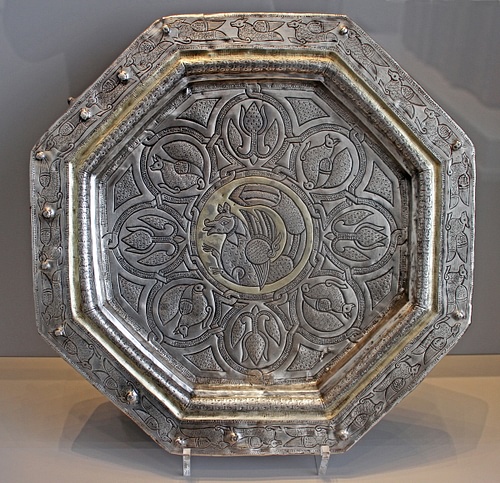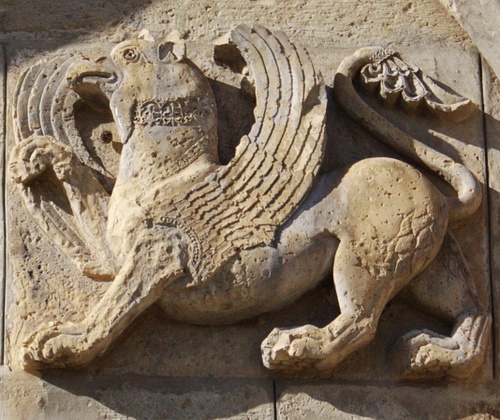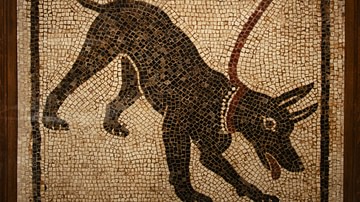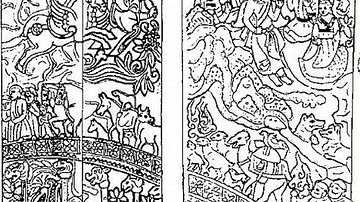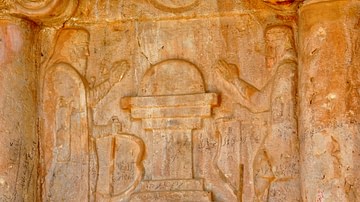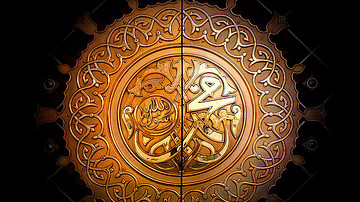Dogs have been an integral aspect of the human condition in virtually every world culture for thousands of years. Some of the greatest civilizations of the past have kept dogs as companions, for various chores, and featured dogs in their art, literature, and elevated them to important positions in religious belief and, among these, were the Persians.
The dog was highly valued in ancient Persia as they were considered part-wild, part-human, and part-divine, a gift from the gods.
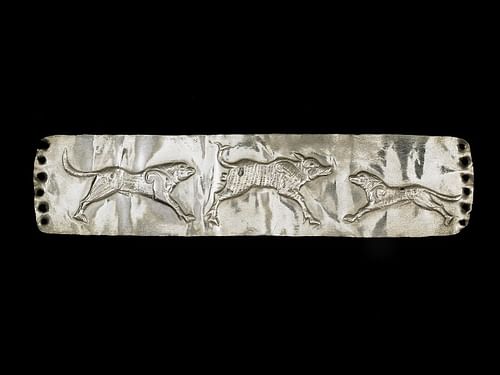
Although little is known of the early religious beliefs of the Persians prior to the rise of Zoroastrianism (c. 1500-1000 BCE), the dog played a major role in religious rituals as recorded by Zoroastrian texts. Dogs were an important part of funerary rituals and held center stage in the vision of the afterlife from an early date as well as performing important functions in people's daily lives.
The Persians kept dogs for protection, herding, and hunting but grave goods and archaeological evidence suggests that they were also kept for companionship, and this is further supported by how the section of the Avesta (Zoroastrian scripture) known as the Vendidad emphasizes the importance of treating a dog as well as one would a member of one's own family. How one treated a dog, in fact, would directly affect whether one was rewarded or punished in the afterlife according to Zoroastrian belief.
The Persian love of the dog was so profound and well-known to their neighbors that persecution of dogs became a means whereby the Muslim Arab conquest subdued the population in the invasions of the 7th century CE. As in every instance of a new religious-political system trying to assert dominance over the cultural values of a conquered people, the dog was proclaimed unclean – especially the so-called “four-eyed dog” (a dog with a spot above each eye) - which had been held in the highest regard by the Persians.
Although the Prophet Muhammad is said to have reversed his decision to kill all dogs and allowed for certain types to be kept by Muslims, persecution of dogs which were not guard dogs, hunting dogs, or sheep dogs continued. In the present day, the Iranian government continues policies targeting dogs and dog owners - even though the more severe proscriptions have been relaxed - and many modern-day Persians and animal rights groups continue working to restore the dog to its former stature in the country.
Domestication & Breeds
When and where the dog was first domesticated continues to be debated, but evidence (such as dogs interred with people in graves) suggests that dogs were already domesticated in the Near East as early as 12,000 BCE even though, according to scholar Frank Hole, confirmation of full domestication dates only to 5,500 BCE based on osteological evidence (the study of bones) which shows wear and injuries consistent with domestic roles. Dogs were important enough to the people, c. 5,500 BCE, to merit depiction on ceramics, as Hole notes:
Around 8,000 years ago, at a time when naturalistic pictures of any kind were rare on pottery, dogs were painted on vessels from Tepe Sabz in Deh Luran and Chogha Mish in Khuzistan, two small-scale agricultural villages in southwestern Iran. (175-176)
These early images suggest the Saluki breed (also known as the Persian Greyhound, Gazelle Hound), and this motif would be repeated later on a much grander scale at the city of Susa (founded 4395 BCE), as Hole also mentions:
Following the depiction of dogs on the early bowls of Tepe Sabz and Chogha Mish, there was a succession of regional ceramic styles during the next 1,500 years culminating in the Susa-A style. (176)
The dog images were painted inside the bowls, suggesting that these ceramics were used for ornamentation, not for daily use. Hole notes how the delicacy of the images suggests they were made to be admired, not covered with food. The Saluki, as noted, is the breed most often depicted but other breeds are known to have been kept by the Persians, including:
- Afghan Hounds
- Alabai (the Central Asian Shepherd)
- Persian Sarabi Mastiff
- Pshdar Dog (Kurdish Mastiff)
The Roman historian Claudius Aelianus (better known as Aelian, l. c. 175 - c. 235 CE), whose work De Natura Animalium (“On the Characteristics of Animals”) devotes significant space to dogs, claims that the Persians kept four main types – Elymaeans, Hyrcanians, Carmanians, and Medians – which correspond roughly to the breeds mentioned above. Aelian's observations are taken from the earlier work of Pliny the Elder (l. 23-79 CE) who also makes mention of notable dogs in Persian and Greek history and the devotion they regularly showed to their masters.
Dogs in Myth & Legend
The loyalty of the dog and its role as protector and guardian features significantly in the myths concerning its origin. The collection of Zoroastrian lore known as the Bundahisn claims that all animals were created from the purified semen of Gavaevodata (usually referenced as the Primordial Bull) whose death gives them life. The dog is created to protect human beings and the Bundahisn (13.18) lists ten types with only three – the sheep dog, guard dog, herd dog – considered actual dogs.
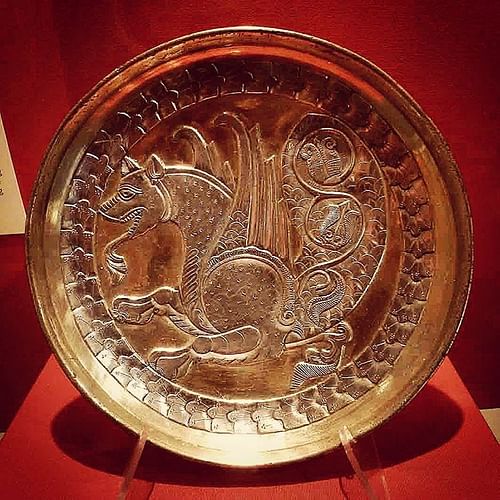
The dog is also associated with the mythological creature Simurgh – the great and benevolent bird of wisdom depicted as a peacock with a dog's head and lion's claws and often referred to as the “dog bird”. The Simurgh is said to have acquired the wisdom of the ages through a long life of 1,700 years (according to some versions of the myth), after which it dies in flames and is reborn like the Phoenix. The Simurgh is a protector and helper, most famously assisting in the birth of the Persian hero Rustum. The loyalty Simurgh shows to those she is attached to mirrors the devotion of the dog, as does her protective aspects.
This central quality – of protector – is the main focus of the Islamic versions of the creation of the dog and its purpose, all written after the 7th century CE. In one of these, after Adam and Eve are expelled from the Garden, Iblis (Satan) encourages the wild animals to attack and kill them. Iblis is so passionate in rousing the beasts that spit flies out of his mouth, and Allah then forms the spittle into dogs – a male and female – and places the male as protector over Adam and the female to protect Eve. The central role of the dog as protector is emphasized but the myth also serves to explain the enmity between the dog and wild animals, especially the wolf.
Dogs in Religion
A related tale, also from post-conquest literature, has Allah send Adam a magical staff for protection against Iblis and the wild animals. Adam, not understanding the role of the dog, strikes it with the staff and is corrected by Allah who commands he should pat the dog instead. As Adam pats it, the dog becomes domesticated and henceforth serves as Adam's friend and protector. This theme was no doubt suggested by the nature of the dog and how it was most commonly employed by humans, but dog-as-protector has a long history in the Persian religious belief system where one's treatment of the dog played a critical part in the quality of one's life after death.
The importance of dogs is defined in the Vendidad where they are described as benevolent, clean, protective, and worthy of respect and human protection. An important aspect of the Persian funerary ritual was the sagdid (“glance of the dog”) in which a dog – preferably one with “four eyes” (a spot above each eye) – was brought into the room where the newly deceased was laid out. The purpose was twofold: the dog would be able to tell if the person was actually dead (and so mortuary rituals could proceed) and the dog would scare away any evil spirits hovering around the body.
The sagdid was enacted three times before rituals could then proceed but, if the dog appeared unwilling any of those times, the rite was repeated six more times. If the dog showed any hesitation in entering the room any of these times, it was then led in again nine more times. Presumably, the dog was reacting to the presence of particularly powerful evil spirits upon whom its energies as guardian and protector needed more time to work. Only once the dog entered the presence of the corpse willingly and without drawing back was the sagdid concluded and other rites performed.
After death, the soul would journey to the Chinvat Bridge which spanned the abyss between the world of the living and the lands of the dead. Two dogs guarded the bridge and, as one was to cross, these dogs would welcome the righteous but not the condemned. The bridge would widen for the virtuous soul and narrow for those who had led evil lives.
Justified souls would continue on to the paradise of the House of Song; evil souls would be dropped into the hell of the House of Lies where they would be tormented and, further, would experience a devastating loneliness – no matter how many other souls were around them, they would feel always alone.
A major determinant of where the soul went was how they had treated dogs during their lifetime. People were supposed to care for dogs as they would their own family members and, just as one would not intentionally hurt or kill a loved one, so one should not do so with a dog. Further, as one meant only the best for one's family, so should one act toward a dog. The dog's soul was thought to be a combination of one-third wild animal, one-third human, and one-third divine and so commanded the level of respect one would show to all three of these kinds of energies.
Dogs in Daily Life
Pregnant dogs – even strays – were to be cared for and good homes found for their puppies. Vendidad 13 makes clear that anyone who purposefully injures a dog will be beaten and that dogs should be served the same quality food as one would present to the master of the house. Serving food that is too hard, and might injure a dog's teeth, was considered as serious an offense as intentionally hurting the dog and foods should be neither too hot nor too cold. It is stipulated that one should save three morsels from one's daily meal as a gift to the dog, in addition to whatever else it has had to eat.
Infirm dogs were to be cared for with just as much diligence as those who were sound and productive. A mad dog was to be calmed and cured of its madness, and one which had lost its ability to scent was to be guided by collar and leash so that it would not venture off and, unable to detect a predator or some other danger, come to harm. Vendidad 13.6.39 makes clear that people are to take care of injured dogs, not only because it is the right thing to do but also in return for all the dog has done for them. The passage cites the supreme deity Ahura Mazda stating:
I have made the dog strong of body against the evil-doer when sound of body and watchful over your goods. And whosoever shall awake at his voice, neither shall the thief nor the wolf carry anything from his house without his being warned; the wolf shall be smitten and torn to pieces; he is driven away, he melts away like snow. (13.6.39-40)
The dog had been provided for human beings as a gift from Ahura Mazda, and the deity expected that gift to be well-cared for. Insulting a dog was thought to bring a divine reprimand because the person was presuming to elevate themselves over the dog without any good reason. Dogs, after all, did not insult humans and, in spite of all the good they provided, remained ever humble. Punishments for injuring a dog on purpose include beating with up to “seventy stripes” and, if one accidentally harmed another person's watchdog, herd dog, or hunting dog, one would have to pay for treatment and, further, compensate the owner if the dog was unable to perform its duties because of the injury.
The hunting dog, guard dog, and shepherd dog are mentioned most frequently, and these seem to have been the Saluki and Afghan (hunters), Pshdar and Sarabi Mastiff (guardians), and Alabai (cattle dogs/sheep dogs, though also guard dogs). These dogs helped procure food for their masters, protected that food and the home from threats, and guarded their masters' herds in the fields. Further, the dog protected the individual owner from harm as well as members of the family and was equated with health and healing thus making the dog a vitally important aspect of the Persians' daily lives even if it were not so prominently featured in mortuary rituals and the vision of the afterlife.
Conclusion
After the Muslim Arab conquest of the 7th century CE, dogs were declared unclean – even though dogs are mentioned positively in the Quran – in an effort to denigrate an important Persian cultural value. This declaration is thought to have been politically motivated, having nothing to actually do with religious belief, in order to elevate the conquerors at the expense of the conquered. One of the most famous passages of the Quran, in fact, depicts the dog as the faithful protector of the righteous Seven Sleepers of the Cave, who understand the truth of divine revelation correctly (Sura 18:9-26), and they are presented in a similar light elsewhere.
Muhammad is said to have originally called for a mass cull of dogs but then softened his stance, upon reflection on their beneficial aspects, limiting the death penalty only to black dogs (associated with evil) and those with “four eyes”. The four-eyed dog, as noted earlier, was among the most central to the Persian vision of the afterlife as well as the ritual of the sagdid and so, clearly, this was an effort to undermine Persian culture in order to replace it with the vision of the conquerors.
In time, Persian values would be adopted by the Muslim Arabs – entire dynasties, in fact, would be Persian – and the art, architecture, and other aspects of the culture would become associated with the Arabian Muslim belief system. This same paradigm applies to the dog only to a far lesser degree because of the Muslim religious obligation to pray five times a day and to be ritually clean in order to do so. The presence of a dog, as an unclean animal, would require one to purify one's self before prayer.
Even so, dogs are owned by Muslims around the world in the present day and government proscriptions against dog ownership, such as those in Iran, are not as harsh as they were in the past and make allowance for keeping a guard dog, sheep/cattle dog, and hunting dog as per Muhammad's ruling on the subject – the same types of dogs, notably, that the Persians valued themselves thousands of years ago. Still, the Iranian government periodically initiates crackdowns on walking dogs in public and dog ownership in general – largely, it seems, in an effort to prevent Iranian emulation of Western cultural values – ignoring the long cultural heritage of the Persian people as a dog's best friend.
